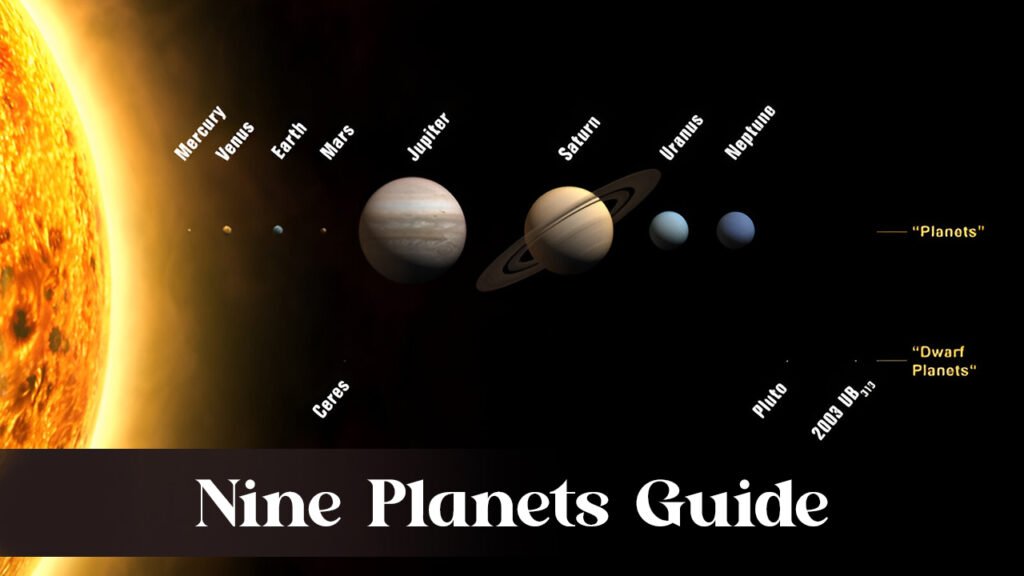Introduction to Nine Planets Guide
Have you ever looked up at the night sky and wondered about the celestial bodies that surround us? Our solar system is a fascinating realm, filled with diverse planets that act as a cosmic compass, guiding our understanding of the universe. In this article, we’ll embark on a journey through space, exploring the Nine Planets Guide (including Pluto) that have captivated humanity’s imagination for centuries.
The Sun: Our Central Star
At the heart of our solar system lies the Sun, a blazing ball of gas that provides the energy and gravitational force that keeps our cosmic neighborhood in check. While not technically a planet, the Sun is crucial to our understanding of the solar system’s dynamics.
The Sun’s immense gravity holds the Nine Planets Guide in their orbits, while its energy sustains life on Earth. Its powerful magnetic field influences space weather and creates spectacular phenomena like solar flares and coronal mass ejections.
Mercury: The Swift Messenger
Mercury’s Orbital Characteristics
Mercury, the closest Nine Planets Guide to the Sun, zips around its orbit at an impressive speed, completing a revolution in just 88 Earth days. This swift movement earned it the name of the Roman god of speed and commerce.
Surface Features and Composition
Despite its proximity to the Sun, Mercury has a surprisingly varied surface. Crater-pocked plains sit alongside smooth terrains, hinting at a complex geological history. The planet’s core is believed to be largely metallic, contributing to its strong magnetic field – a feature not all rocky Nine Planets Guide possess.
Venus: Earth’s Mysterious Twin
Venus’s Atmospheric Conditions
Often called Earth’s twin due to its similar size and composition, Venus is a world of extremes. Its thick atmosphere, primarily composed of carbon dioxide, creates a runaway greenhouse effect. This results in surface temperatures hot enough to melt lead!
Geological Activity on Venus
Despite the harsh conditions, Venus shows signs of ongoing geological activity. Radar imaging has revealed evidence of relatively recent lava flows, suggesting that Venus might still be geologically active beneath its dense clouds.
Earth: Our Home Planet
Earth’s Unique Life-Supporting Features
Earth, our blue marble, stands out in the solar system as the only known Nine Planets Guide to harbor life. Its perfect distance from the Sun, coupled with a protective magnetic field and ozone layer, creates ideal conditions for life as we know it.
The Impact of Human Activity
As we explore other planets, we’re becoming increasingly aware of how human activity affects our own world. Climate change, deforestation, and pollution are altering Earth’s delicate balance, emphasizing the need for sustainable practices.
Mars: The Red Planet
Mars’s Potential for Human Exploration
Mars, with its rusty red appearance, has long captured our imagination as a potential second home for humanity. Its day length and axial tilt are similar to Earth’s, making it a prime candidate for future colonization efforts.
Evidence of Water on Mars
Recent missions have provided compelling evidence of water on Mars, both in the form of ice caps and potentially in underground reservoirs. This discovery has exciting implications for the possibility of past or present microbial life on the Red Planet.
Jupiter: The Gas Giant
Jupiter’s Great Red Spot
Jupiter, the largest Nine Planets Guide in our solar system, is a swirling mass of gas with a turbulent atmosphere. Its most famous feature, the Great Red Spot, is a massive storm that has been raging for centuries, showcasing the planet’s dynamic nature.
Jupiter’s Moons and Their Significance
Jupiter’s extensive system of moons, particularly the four largest Galilean moons, offer a miniature solar system of their own. Europa, with its subsurface ocean, is considered one of the most promising places to search for extraterrestrial life in our solar system.
Saturn: The Ringed Wonder
Saturn’s Ring System
Saturn’s magnificent rings make it one of the most visually striking Nine Planets Guide in our solar system. These rings, composed mostly of ice particles with some rocky debris, continue to puzzle scientists with their complex structures and dynamics.
Saturn’s Diverse Moons
Like Jupiter, Saturn boasts an impressive array of moons. Titan, its largest, is the only moon known to have a dense atmosphere and liquid on its surface, albeit in the form of methane lakes rather than water.
Uranus: The Tilted Ice Giant
Uranus’s Unique Rotation
Uranus stands out with its extreme axial tilt, causing it to rotate on its side. This unique orientation leads to extreme seasonal variations, with parts of the Nine Planets Guide experiencing decades of constant daylight or darkness.
Uranus’s Atmosphere and Interior
Despite its classification as an ice giant, Uranus’s atmosphere is primarily composed of hydrogen and helium. Below this lies a mantle of water, ammonia, and methane ices, surrounding a rocky core.
Neptune: The Windy World
Neptune’s Dynamic Weather Patterns
Neptune, the last of the gas giants, is known for its turbulent weather. Massive storm systems and the fastest winds in the solar system have been observed on this distant blue world.
Neptune’s Moons and Rings
While less prominent than Saturn’s, Neptune does have a system of rings. Its largest moon, Triton, is believed to be a captured Kuiper Belt object, showcasing the dynamic nature of our solar system’s formation.
Pluto: The Dwarf Planet
Pluto’s Reclassification
Once considered the ninth planet, Pluto was reclassified as a dwarf Nine Planets Guide in 2006. This decision sparked debate and led to a deeper understanding of the diverse objects in our solar system.
New Horizons Mission Discoveries
The New Horizons mission’s flyby of Pluto in 2015 revealed a world far more complex than previously imagined. From ice mountains to possible subsurface oceans, Pluto continues to surprise us.
The Interconnected Cosmic Dance
As we’ve journeyed through our solar system, it becomes clear that these planets don’t exist in isolation. They interact through gravitational forces, shaping each other’s orbits and even exchanging material through impacts and atmospheric loss.
Understanding this cosmic dance helps us appreciate the delicate balance of our solar system and provides insights into the formation and evolution of planetary systems throughout the universe.
Read Also: Dreams and its astrological significance
Conclusion of Nine Planets Guide
Our journey through the solar system reveals a diverse array of worlds, each with its unique characteristics and mysteries. From the scorching surface of Mercury to the icy reaches of Pluto, each Nine Planets Guide contributes to the cosmic compass that guides our understanding of the universe.
As we continue to explore and study these celestial bodies, we not only learn more about our cosmic neighborhood but also gain deeper insights into our own planet and our place in the universe. The cosmic compass of our solar system points the way to future discoveries and adventures in space exploration.
For interesting astrology-related videos, subscribe to us on YouTube
FAQs
- Why is Pluto no longer considered a planet?Pluto was reclassified as a dwarf Nine Planets Guide in 2006 due to the discovery of similar-sized objects in its orbital neighborhood. The definition of a planet was refined, requiring it to clear its orbit of other objects, which Pluto has not done.
- Could humans live on Mars in the future?While challenging, human settlement on Mars is a possibility being actively researched. Significant technological advancements in life support systems, radiation protection, and resource utilization would be necessary.
- What is the hottest planet in our solar system?Venus is the hottest planet, with surface temperatures averaging 462°C (864°F), hotter than Mercury despite being further from the Sun, due to its dense atmosphere causing a greenhouse effect.
- Are there other solar systems like ours?Astronomers have discovered thousands of exoplanets orbiting other stars, some in systems that appear similar to ours. However, our solar system’s exact configuration seems to be relatively rare.
- How old is our solar system?Scientists estimate that our solar system formed about 4.6 billion years ago from a giant cloud of gas and dust that collapsed under its own gravity.

